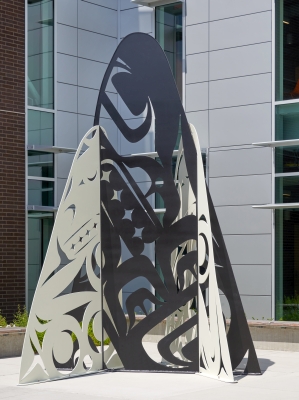About the Artwork
James Madison’s (Snohomish and Tlingit) Family sculpture representing intersecting Orca whale fins is about family and unity on many levels. The three Orca fins represent Madison’s own family—him and his two boys—and the bond that they have. It also represents the importance of passing down traditional information from one generation to the other.
Madison’s design is steeped in a traditional Northwest Coast style that represents his Tlingit and Salish (Tulalip) heritage. By including both styles, he shows the importance of protecting the Orca all along the Northwest Coast, from Washington to Alaska.
This artwork was acquired for the State Art Collection in partnership with Edmonds College.
About the Artist
Tulalip Tribes member James Madison (Tulalip and Tlingit) is a master wood carver. He also works in glass, bronze, and stainless steel, and seeks to combine the new with the old. Madison notes that he is “always thinking of new ways to add a modern twist to a traditional piece. This allows for me to help to keep my culture alive. As we move into the future, so do the teachings of my ancestors.”Madison was born into a family steeped in traditional Salish and Tlingit Northwest Coast Native art. He began carving when he was 8 years old, learning from his grandfather, uncle, and father. He earned a Bachelor of Fine Arts degree from the University of Washington in 2000, followed by a Bachelor of Fine Arts degree from the Pratt School of Fine Arts in 2004 (both in Seattle). One of Madison's major works is a 24-foot story pole at the Tulalip Casino. His artwork can also be seen at Providence Hospital in Everett, the Burke Museum at the University of Washington.









_edited.jpg)
